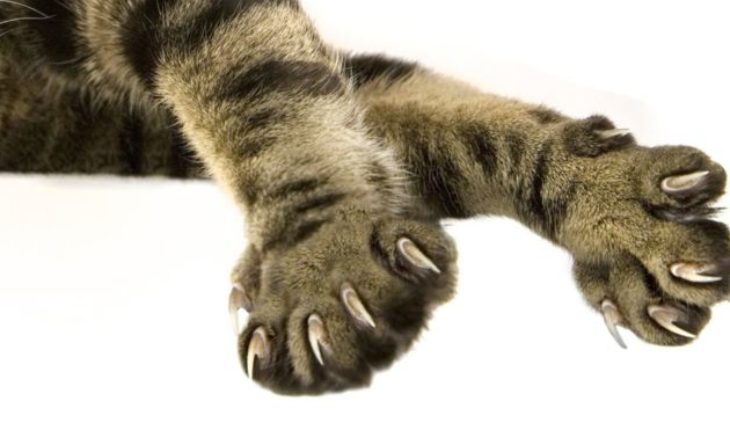New York could become the first state in the United States. To prohibit the amputation of the claws of the Cats.
Legislators voted last Tuesday to make the procedure illegal, except when medically necessary for the cat.
The project only needs the signature of the governor, Andrew Cuomo, to become law.
Why are cats so selfish?
Critics of this practice, which involves cutting a bone segment attached to the claw, qualify it as “barbaric and inhumane.”
But the veterinary Medicine Society of New York argues that it should still be an option in cases where the cat can be abandoned or slaughtered.
Amputation of cat claws is already illegal in many European countries, including the United Kingdom, and also in Brazil, Israel, Australia and New Zealand.
Why do people amputate the claws of their cats?
Many countries in the world prohibit amputating the claws of cats, an apparently frequent practice in the United States. The most frequent type of amputation is called oniquectomía or hooked on and consists of cutting the bones in which the claws grow with a scalpel or Laser.
Opponents of it are compared to cutting the fingers or toes in the upper joint and saying that amputation can affect the balance of cats.
There are some cases where surgery is medically necessary, “if there is a serious infection or a tumor,” says Dr. Sarah Endersby, veterinary development manager of the International Cat Care charitable organization.
However, he adds that many people amputate the claws of cats to avoid scratching the furniture, which she qualifies as “an act of mutilation done to modify the cat in our benefit.”
Die Grumpy Cat, the famous internet cat
While many European countries signed a treaty in the early 1990 that banned this practice, a survey of the AP agency in 2011 showed that 55% of us cat owners said they felt good to amputate the claws of their feline pets.
Some studies say that between 20% and 25% of domestic cats in the U.S. have been subjected to this amputation.
On the contrary, “claw amputation was always something strange” in the UK, even before it was declared illegal in 2006, says Professor Danielle Gunn-Moore, veterinary and president of feline medicine at the University of Edinburgh.
“It wasn’t something we were taught in college,” he adds.
What is the most famous cat in the UK? Probably Larry, who shares his home with Prime Minister Theresa May. U.S. customs
“A big difference (with other countries) is that many more cats in the U.S. are exclusively in closed places,” says Dr. Sarah Ellis, feline behavioral expert at International Cat Care.
Experts believe that Americans are more likely to keep cats inside because many live in high-rise buildings in the city.
Why is a town in New Zealand trying to ban cats?
Meanwhile, in rural areas of the United States, where predators such as coyotes and wolves are more likely, it is not safe to amputate the claws of cats, as they may need them to protect themselves.
But there is also a different culture among Americans, says Judd Birdsall, a cat-lover and former American diplomat who now lives in the UK.
“For Americans, it’s a matter of freedom and convenience. It is about the right to freedom to make decisions in terms of how to raise your cat. And convenience because once the claws are amputated, you don’t have to worry about your person or the furniture being scratched, “he says.
Which are better? Indoor or outdoor cats?
Indoor cats tend to live longer but need a suitable environment. Indoor cats tend to live longer because they are less likely to be hit by cars or to catch feline viruses.
However, indoor cats need a suitable environment, otherwise they are much more likely to develop psychological problems.
Indoor cats that share the home with other cats are more likely to experience stress-related disorders if they don’t get along, because cats are naturally solitary animals.
Outdoor cats can express their inherent behavior more easily, such as hunting and playing with insects.
Veterinarians say that outdoor cats may look braver and more psychologically balanced as they face challenges several times a day.
Source: Professor Danielle Gunn-Moore, Steve Dale, International Cat Care
Why is the amputation of cat claws so controversial?
Amputation of the claws of cats can cause many health problems for these animals. Many experts cite studies suggesting that amputee cats are more likely to have health problems, such as spine pain or behavioral problems.
“Some studies say that cats that were amputated have a higher percentage of cortisol (the stress hormone), which is often associated with pain,” says Steve Dale, animal behavior consultant and pet journalist in Chicago.
Meanwhile, a study that examined the paws of the Clawless cats revealed that “many people do not do it properly, leaving bone fragments,” says Professor Gunn-Moore and adds that this could leave the cats stepping on small bone fragments When they walk.
Is it better to feed pets with homemade food or processed food?
Dr. Endersby says cats can still feel pain after the amputation procedure.
“Part of its weight falls on the toes, therefore, after the amputation process, its gait changes when they put its weight between the legs.”
However, Dr. Drew Weigner, a veterinarian from Atlanta who works at a foundation that finances feline medical research, warns that “behavioral studies are very difficult to perform successfully.”
Many veterinarians simply consider the procedure unethical because it is unnecessary, he says.
Are there situations where amputation should be allowed?
Cats have a chance to go outside they are more likely to scratch and stretch. Many U.S. veterinary associations oppose Prohibition because they say that claw amputation should be allowed as a last resort.
In the UK, Professor Gunn-Moore says she has only done an amputation of two cats when an elderly client was not allowed to stay in a nursing home with her cats unless she could guarantee that they would not scratch the furniture.
As the nursing home did not accept any other option, and as the cats were too shy to be relocated, Gunn-Moore contacted the Royal College of Veterinary Surgeons, who gave him permission to perform the procedure.
“I did the procedure with the purpose of preventing two cats from being slaughtered and the old woman losing her cats, but that disturbed me.”
The surprising outcome of the mystery of the “Cat Killer” in London
The amputation of a cat’s claws “has to be a last resort,” he says, adding that most people perform this procedure for more frivolous reasons.
“Many don’t want to try to train their cats, or they don’t want a scratched armchair in their apartment.”
And even “some people like the way the legs look after the procedure. I’ve had people tell me that their legs look prettier and fluffy when they’re amputated. ”
Some specialists argue that in extreme situations, cats ‘ claw amputation should be allowed. Meanwhile, some veterinarians argue that the procedure may be necessary when homeowners have health problems that put them at risk.
“When my husband was on chemo and his immune system was compromised, amputated my cat’s claws. I love her very much, but I wouldn’t risk her having an infection if she scratched it, “a vet said to the daily Denver Post In 2013.
The latest council of the Centers for Disease Control in the United States is not to recommend patients who amputate the claws of their cats. It simply says that cats stay inside, avoiding the “rough play” that they may be exposed to outside.
The real reason Cats purr
Are things changing in America?
In addition to the proposed legislation in new York state, cities such as Los Angeles and Denver also banned the amputation of cat claws.
“20 years ago, it was something that you did. You had a cat and you amputated it, “says Dr. Weigner. In recent years, however, it became “an increasingly controversial procedure.”
Dale says on his part that, based on his personal experience, the younger veterinarians support the prohibition more, especially since a recent investigation seems to provide evidence against amputation.
There are ways to train cats not to scratch all the furniture in the house. How do I train my cat to not scratch the furniture?
It is normal for cats to scratch, because this is how they mark their territory with their smell and the marks of their claws, says Dr. Ellis.
It also helps them keep their fingernails sharp and stretch their spine muscles.
However, the owners can train the cats to use the scratching posts, although they should be as long as the length of the cat so they can stretch and dragAr his claws down.
The Paradisiac Island of Greece that offers a dream job (for lovers of cats)
Different cats have different preferences about the type of material, and whether the post should be horizontal or vertical, he adds.
“We also need to think about the location: Cats need the Poles in certain prominent places because that’s where they mark their territory.”
Even certain products include pheromones to lure the cats to the Poles, adds Professor Gunn-Moore, who often uses them to train the cats to use the scratching posts.
translated from Spanish: Cat claws: Why do Americans amputate them?
June 8, 2019 |





